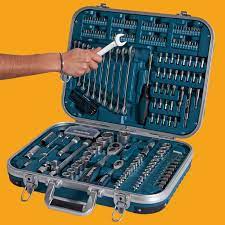How to Read the Toolkit and Pick the Right Tools for Each Job Having the right tools for the job can be helpful, Enjoy the auditory resonance of a wrench or the seamless motion of a screwdriver. Regardless of your level of expertise in do-it-yourself projects or your familiarity with home renovation tasks, selecting a toolbox might present a difficult task. Do not be scared! This course teaches you everything you need to know about toolkits, so you can make intelligent choices and efficiently complete any task.
We’ll look at why high-quality tools are essential for toolkits.
There is more to the toolkit’s price than just a number. It tells you how good it is and how long it will last. Keep in mind that price generally means quality, even if cheap kits look good. There are safety risks that come with getting your process back to normal. It might also give you wrong numbers and bad results because it isn’t very accurate. Getting a high-end toolkit with chrome vanadium steel tools will make sure that your work is safe, effective, and lasts a long time. It’s like putting money into your do-it-yourself projects. In the long run, it will save you money on fixes and stress.
Are you living in a small space? To fix problems, use your imagination and skills.
You can still do DIY projects even if you don’t have much space. Get the most out of your property by using current ways to store things instead. Pick a toolkit with different levels and boxes or parts to keep your tools organised and straightforward to reach. Use tool plans or pegboards that you can hang on the wall to make the most of the space up high. Toolboxes with drawers and wheels are easy to move and store.
You can do more than one job well if you have the right tools. It would help if you tried to get tools that are versatile and can do many tasks. Make sure to make choices that take up a little space. You can make a small but valuable set of tools that will help you with your DIY projects anywhere by using your ideas and common sense.
What all toolkits should have
The tools are the main subject, so let’s talk about them. Each toolkit needs a few essential items. The exact items you need may change based on the projects you’re working on. Get different sizes of flathead and Phillips screwdrivers so you can do a lot of other screw-tapping jobs. You don’t need as many wrenches when you have this handy tool that can fit nuts and bolts of various sizes. Measurements must be correct for a job to go well.
An easy-to-read tape measure is the best choice. For jobs that need to be hit and pushed, pick a claw hammer. A pair of needle-nose pliers can be used along with regular tools to hold and cut. This tool is helpful for many things and can cut through cardboard, rope, and other things quickly. A good levelling tool will help you make sure that the lines going up and down are perfectly straight. Keep your hands and eyes safe. You work hard to put safety first at the same time.
It’s more advanced to talk about how to make your tools fit your needs.
Expand your toolkit with hobby-specific items to take on more difficult do-it-yourself projects. It would help if you had tools like voltage testers and wire cleaners to work with electricity. People who like to work with wood might be interested in a saw, a set of tools, and sanding. As you slowly add to your toolkit, you can be sure that you have everything you need for the job. It could be hard to pick the right toolkit from all the ones that are out there. Think about these necessary things: Pick companies whose items are known for being of high quality.
Think about what you need before you buy it. Don’t buy lots of things that you might not use. Choose a toolbox that will keep your things safe and in order. For faith, pick a toolkit that comes with a promise you can keep. Finding the right toolkit is a one-of-a-kind moment that you’ll never forget. As you get better at the basics, add more complex parts. Remember that quality is more important than quantity. You can quickly finish any job and make your home fit your do-it-yourself style if you have the right tools.
FAQ:
If I don’t have much room for a toolkit, what should I do?
It would help if you were looking for tools that could do many things. You should use a multi-tool or a small toolkit with screwdrivers, other tools, and a pocket knife.
What’s the best amount of time to switch out my tools?
Change out tools that are broken or worn out right away. To keep your instruments in good shape, clean and oil them every day.
What are the best names for toolkits?
Several reliable companies make good toolkits.
How often should I keep my toolkit up-to-date to get the best results?
Make sure your toolkit still fits your needs by checking it often. As you take on more significant tasks or deal with new issues, you should get better at what you do.
What should I do to stay safe when I use power tools from a toolkit?
As the maker tells you, always wear the safety gear that is recommended. Also, have safe places to work with power tools. Get the right skills to make mistakes less likely.

